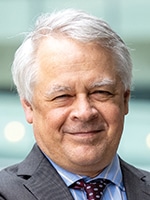New center at Penn Medicine fosters IT collaboration
October 2021—Given Penn Medicine’s reputation for high operational standards, it’s not surprising that the developers of its new Center for Applied Health Informatics set lofty goals for the center: coordinate the efforts of multiple internal technology-related groups to further improve systems institutionwide and position the health system as a global leader in health informatics.
A key goal of the center is to create and implement a system for Penn Medicine to become a “high-reliability organization,” a designation for entities that operate in high-risk environments but are largely error-free, says C. William Hanson III, MD, chief medical information officer at Penn Medicine. This will involve identifying potential weaknesses and building informatics solutions, such as new automated workflows or easier-to-use interfaces, to address them.
“Identifying a set of problems that are of sufficient scale and spinning up a project to remedy or address that problem space is what this center will undertake,” Dr. Hanson says.
The center, launched in late July, is a collaboration between information services, the clinical effectiveness and quality improvement team, the EHR transformation team, and the Center for Health Care Innovation, Center for Evidence-Based Practice, Institute for Biomedical Informatics, Penn Computer Science, and Office of the Chief Medical Information Officer. It is a virtual collaboration and does not occupy a physical space.

Dr. Hanson
The groups participating in the new center are still refining some aspects of its governance, Dr. Hanson says, but representatives of the member groups have been meeting monthly to propose and review potential projects. The center is in the early stages of prioritizing which projects to tackle first, although it has committed to focusing on the evolving needs of the COVID-19 pandemic and expanding telehealth in its first year.
Ideal projects for the center, Dr. Hanson explains, are those that affect multiple departments and would require coordination among several of the center’s member groups to formulate a solution. For example, building a new workflow to ensure that all critical lab results are seen and acted on in a timely manner could require coordination between the EHR transformation team and other technology teams and may help many parts of the hospital, he says.In situations where ordering physicians have been unavailable when critical lab results are released, the pathology department has found it challenging to make sure those critical lab values are seen by someone who can act on them, explains David Roth, MD, PhD, chair of pathology and laboratory medicine and director of the Penn Center for Precision Medicine. “We know who placed the order, but the person who placed the order may be rotated off, or on vacation, or out of the country—whatever. It does come to be a bit of a challenge figuring out who needs to know [the results],” he says. “It may sound trivial but it’s not.”
Dr. Roth anticipates that the new center might also be able to help the pathology department with the difficult task of creating new EHR workflows when testing processes are changed. “If we come up with a better way to diagnose condition X, it is going to need a different workflow for ordering and a different workflow for resulting,” he says. “What I’m hoping is we can turn to the center and say, ‘Help us figure out how to implement this.’”

Dr. Roth
One example of a workflow improvement that may have been achieved more easily with assistance from the Center for Applied Health Informatics involved physicians ordering rapid genotyping for patients who had acute cardiac events and needed cardiac stents. This led to the question of whether these patients could use a generic platelet inhibitor or needed the more expensive one used for patients who are slow metabolizers. “So we tried to stand up a workflow where you could get tested at a point-of-care device, get the results, and then prescribe the correct medication after their stent,” explains Dr. Roth. “The science part was easy,” he adds, “but getting the workflow changes was difficult.”
“If you want to change a [specific] workflow,” Dr. Roth notes, “you have to change the way the EHR workflow works. Therefore, you need a group that’s willing to do things differently, and think about the EHR differently, and understand the needs of the practitioners but also be on the lookout for the needs of the researchers working in the background. I think the integrated nature of the center is going to be helpful in this regard.”
Discussions about creating the Center for Applied Health Informatics began before the pandemic, but plans were delayed as the health system shifted its focus to managing COVID-19 patients. However, several informatics projects have formed through “spontaneous organic collaborations’’ during the pandemic, Dr. Hanson says. These collaborations served as models for the groups working together to develop the center and emphasized the need for a formal collaborative structure, he adds.For example, as the number of patients coming to the hospital rose as the pandemic progressed, the health system created COVID-19 prescreening questionnaires that patients could fill out from home via text, email, or voice mail before going to the hospital. Penn Medicine also has a vaccination mandate for its health care workforce and electronically tracks employee compliance with the mandate. Both of these projects were developed on the fly through collaboration among various groups that are now part of the center, Dr. Hanson says. And because the Center for Applied Health Informatics increases communication and collaboration between technology groups, similar projects should be developed even more quickly in the future.
The pandemic also led to Penn Medicine’s telehealth swelling from approximately 300 visits per month to 8,000 per day. That growth was facilitated by an informatics project called Switchboard, which provided secure, private, virtual spaces for patients to meet physicians, as well as virtual waiting rooms so patients wouldn’t accidentally stumble into another patient’s appointment. While the number of telehealth visits has declined since the worst days of the pandemic, the sharp spike in virtual appointments underscores the importance of creating even more efficient methods for delivering telehealth, which is why telehealth is one of the center’s priorities in its first year, Dr. Hanson says.
As digital pathology gains ground, Dr. Roth also expects there will be a need for new workflows that better integrate digital pathology data with relevant data from other departments to provide context to help with diagnoses. The pathology and radiology departments have already begun to collaborate on identifying complementary data points that doctors in subspecialties, such as soft-tissue pathology and soft-tissue radiology, both recognize and flag when they use digital pathology and digital radiology, respectively. Integrating this digital data into meaningful workflows will require coordinated assistance from several of the groups that are now working together more closely through the center, he says.
“Right now,” Dr. Roth adds, “we have streams of genomic data, of lab data, and streams of EHR data. We have digital radiology data, and we are starting to have digital pathology data. How do we integrate all that and get the most clinical impact out of it?”
 CAP TODAY Pathology/Laboratory Medicine/Laboratory Management
CAP TODAY Pathology/Laboratory Medicine/Laboratory Management
